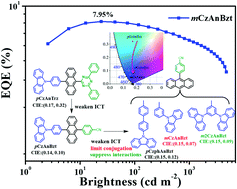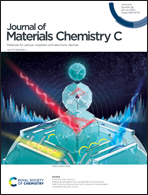Molecular engineering of anthracene-based emitters for highly efficient nondoped deep-blue fluorescent OLEDs†
Abstract
Anthracene moieties are suitable for constructing efficient blue-emitting materials. In this study, three novel bipolar anthracene-based compounds 4-(10-(4′-(9H-carbazol-9-yl)-[1,1′-biphenyl]-4-yl)anthracen-9-yl)benzonitrile (pCzphAnBzt), 4-(10-(3-(9H-carbazol-9-yl)phenyl)anthracen-9-yl)benzonitrile (mCzAnBzt) and 4-(10-(3,5-di(9H-carbazol-9-yl)phenyl)anthracen-9-yl)benzonitrile (m2CzAnBzt) were designed and synthesized using Suzuki coupling reactions. We have demonstrated clearly that the chemical structures of the side groups have significant influence on the thermal, photophysical, and electroluminescence properties. The deep-blue emission of the emitter can be realized by restricting the intramolecular π-conjugation, twisting the molecule conformation and introducing a large substituent causing steric hindrance to suppress the π–π stacking interactions. Besides, all three compounds showed excellent performances in nondoped electroluminescent devices, especially mCzAnBzt, which presented deep-blue emission with CIE coordinates of (0.15, 0.07) and a maximum external quantum efficiency of 7.95%. The performance matched NTSC color purity and was one of the best in nondoped deep-blue devices.



 Please wait while we load your content...
Please wait while we load your content...